Physical Address
304 North Cardinal St.
Dorchester Center, MA 02124
Physical Address
304 North Cardinal St.
Dorchester Center, MA 02124

Infant air travel doesn't have to be chaos—these 12 game-changing strategies will revolutionize your flying experience in ways you never expected.
Flying with your baby doesn’t have to be the nightmare you’ve imagined. While it’s true that air travel with an infant requires extra planning and patience, you can absolutely make it work smoothly with the right approach. The key isn’t avoiding potential challenges—it’s preparing for them strategically. From timing your departure to packing the essentials, there are specific techniques that’ll transform your journey from stressful to manageable, and some might surprise you.
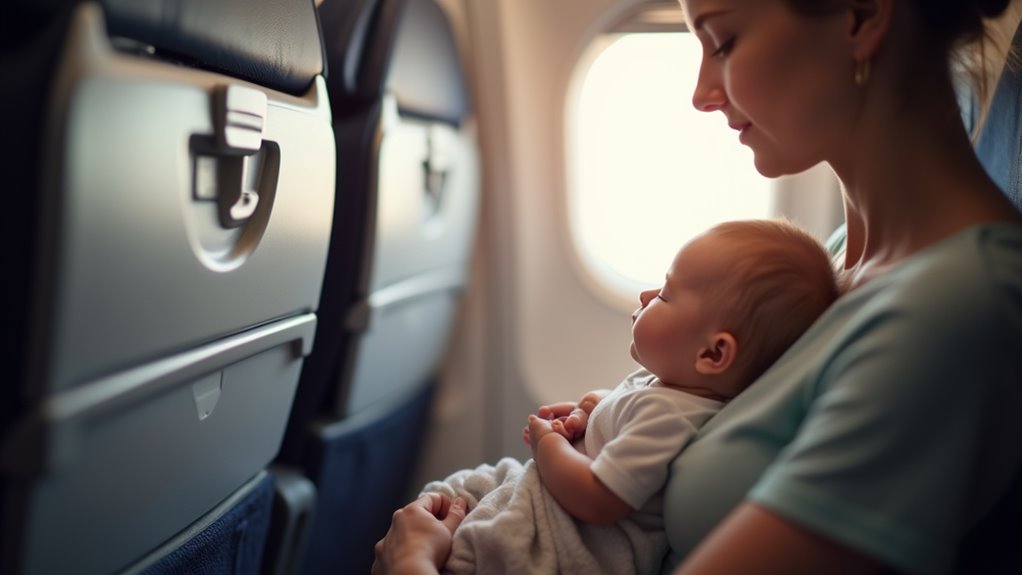
Before you book that flight, take a moment to honestly assess whether your little one is truly ready for air travel. Most infants reach ideal flying readiness between 6-12 months when their immune systems have matured and they’ve developed more predictable routines.
Look for key readiness signs: your baby can communicate basic needs through crying or babbling, handles new environments without excessive fussiness, and maintains a stable sleep schedule.
If your infant is constantly fighting illness or struggling with major routine changes, it’s wise to postpone travel.
Consider your own confidence level too. You’ll need to stay calm under pressure and manage unexpected challenges mid-flight. Remember that a valid passport is required for all children, including infants, so ensure this essential document is ready well before your departure date.
When both you and your baby feel ready, air travel becomes much more manageable for everyone involved.

While most airlines welcome infants as passengers, they’ll require medical clearance if your baby is younger than 7-14 days old. This policy protects newborns from infection risks and travel stress when their immune systems are most vulnerable.
You’ll need a written letter from a physician who’s physically examined your baby, stating they’re healthy enough to fly. The letter should include the exam date and fitness assessment. Keep the original document in your carry-on for easy access during check-in and boarding.
Don’t forget to bring your baby’s birth certificate as proof of age. Airlines rarely make exceptions to this requirement, so contact your carrier before booking to confirm their specific policies. Consider purchasing a seat for your infant to use an FAA-approved safety seat, which provides better protection than holding them on your lap during the flight.
Planning ahead guarantees you’ll have proper documentation ready.
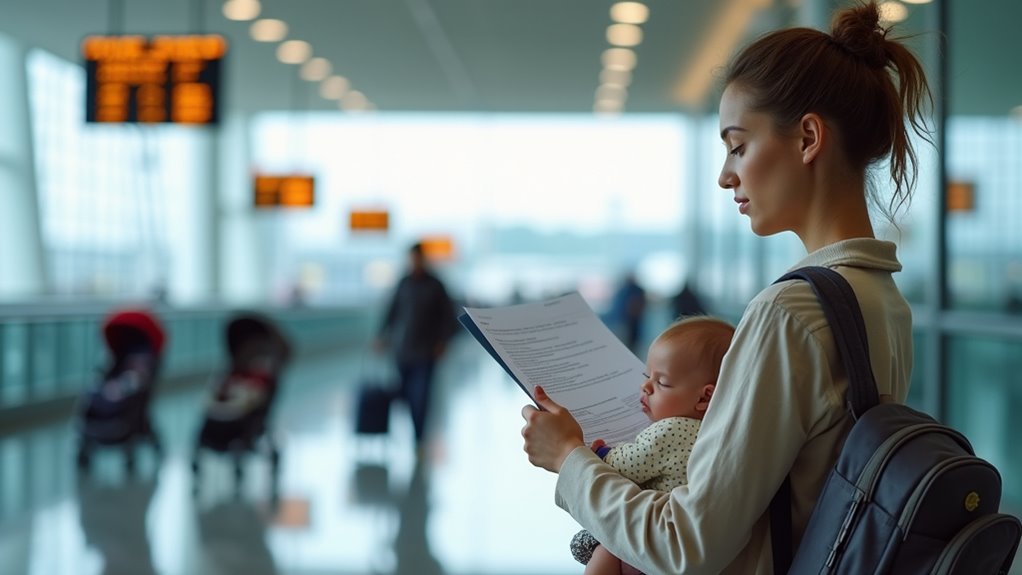
Each airline sets different rules for infant travel, so you’ll want to check your carrier’s specific policies before booking your flight. Most airlines allow infants under 2 to travel on your lap, but you’ll need to include them in your reservation.
If you’re traveling internationally, expect to pay around 10% of the adult fare for your lap infant.
Consider these key factors when researching policies:
When traveling domestically, you can typically add your infant to your reservation by following the airline’s step-by-step guide for completing the Infant-in-Arms request process.
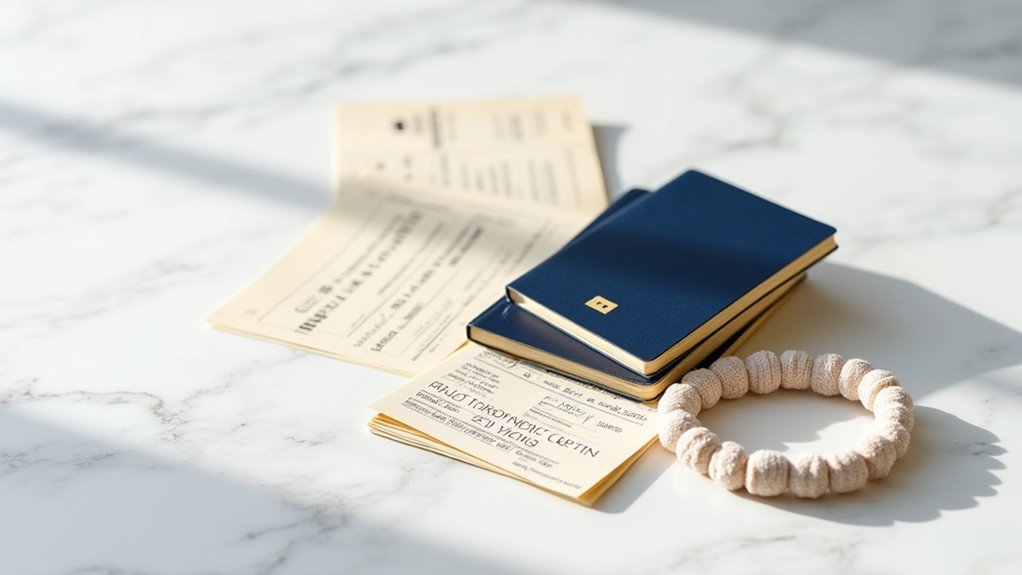
Getting your infant’s travel documents in order requires different preparations depending on whether you’re flying domestically or internationally.
For domestic flights, you won’t need personal ID for your infant—your identification covers both of you. However, you’ll still need a boarding pass or Boarding Verification Document for your baby, even as a lap infant. Proof of age, such as a birth certificate, may be needed for children under 18.
Your ID covers both you and your infant on domestic flights, but baby still needs a boarding pass.
International travel demands more preparation. Your infant must have their own passport regardless of age, plus any required visas.
Carry your child’s birth certificate for verification purposes. If you’re traveling alone with your infant, bring notarized consent letters from the other parent to avoid complications at border control.
Always check your airline’s specific policies and your destination’s requirements well before departure to prevent last-minute surprises.
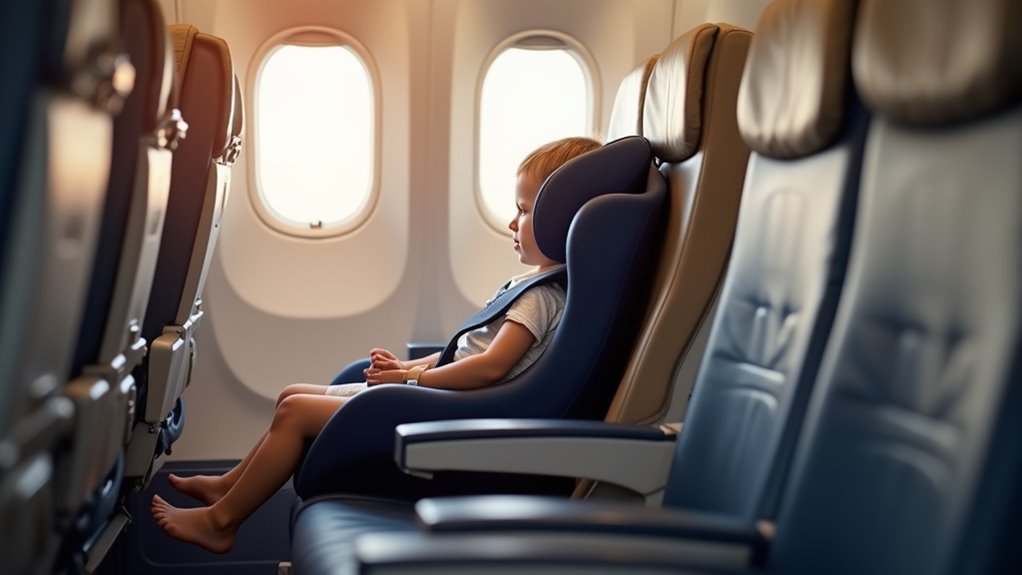
Your infant’s safety reaches its peak when you secure them in an FAA-approved car seat rather than holding them on your lap during flight.
Turbulence and sudden movements pose real risks to unrestrained lap children, making a certified child restraint system your best protection.
Only use car seats labeled for both motor vehicle and aircraft use.
Check this certification before you travel—it’s non-negotiable for airline approval.
Here’s what proper car seat use protects your baby from:
You’ll need to purchase a separate ticket, but your child’s safety is worth every penny. Consider using protective bags for your car seat during travel to keep it clean and undamaged.
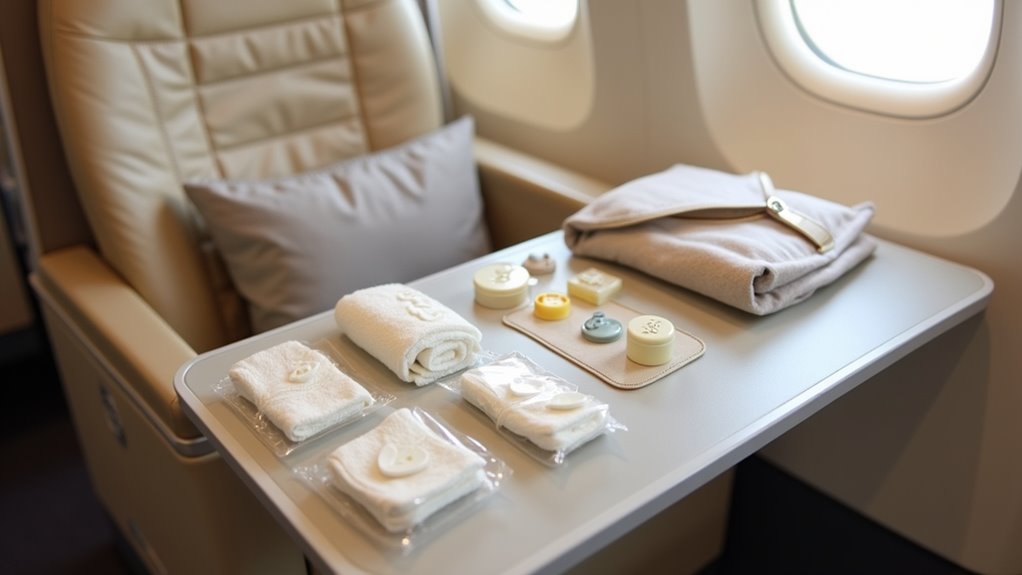
While preparing for air travel with your infant might feel overwhelming, smart packing transforms potential chaos into manageable moments.
You’ll need one diaper per hour of transit plus extras for delays, along with plenty of wipes and a portable changing pad. Pack two complete outfit changes for baby and one for yourself—trust us, you’ll appreciate having backup clothes when accidents happen.
Don’t forget feeding essentials like bottles, pre-measured formula, and baby food in jars or pouches. The airplane’s low humidity environment makes staying hydrated especially important for your baby’s comfort during the flight. Bring pacifiers to help with ear pressure during takeoff and landing, plus comfort items like favorite toys or blankets.
A lightweight stroller and baby carrier will keep your hands free while maneuvering through airports, making your journey smoother from departure to destination.
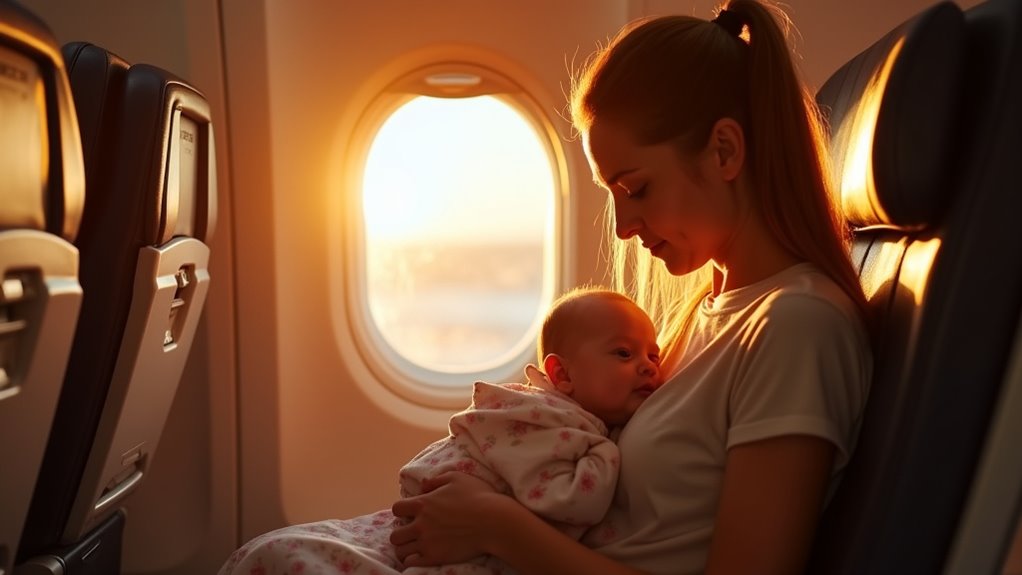
As your plane prepares for takeoff, timing your infant’s feeding becomes your most powerful tool for preventing ear discomfort and tears. The sucking motion from breastfeeding, bottle feeding, or pacifier use helps balance ear pressure naturally.
Start feeding as the plane begins moving—don’t let your baby finish before takeoff begins.
Time your baby’s feeding to coincide with takeoff—starting too early means missing the crucial pressure-balancing window.
Here’s what makes the biggest difference:
You’re allowed to feed your infant in your lap during all flight phases. Bring an insulated cup with hot water to heat bottles or formula if needed before boarding.
Whether you breastfeed, bottle-feed, or offer a pacifier, you’ll transform potentially stressful moments into soothing comfort for your little one.
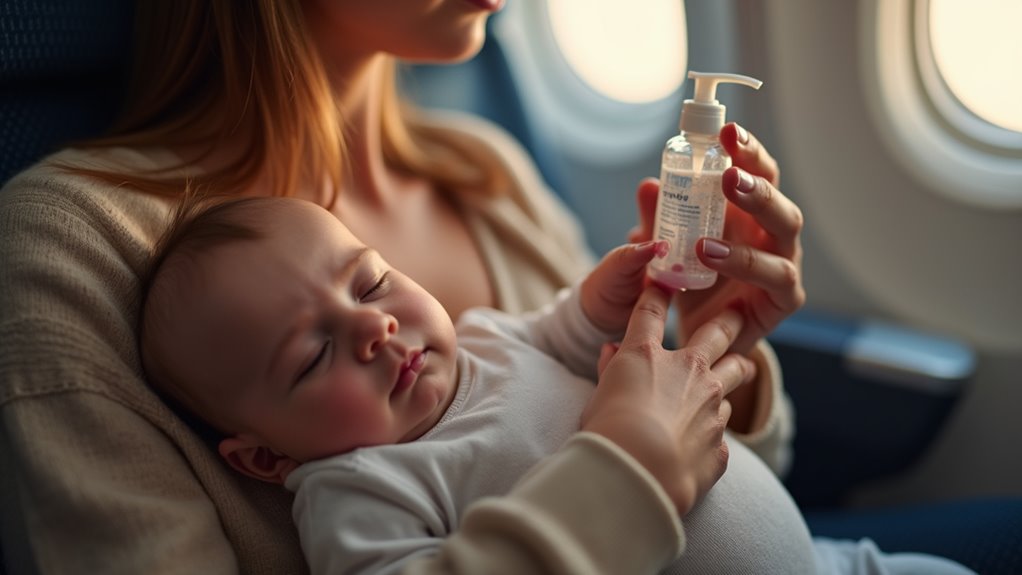
Twenty percent of airport travelers have clean hands—a sobering statistic that puts your infant at unnecessary risk during one of travel’s most germ-heavy experiences.
Since infants are particularly vulnerable to infections, your diligent hand hygiene becomes their primary shield against disease.
Wash your hands thoroughly before touching your baby, especially after passing through security checkpoints and boarding gates where germs concentrate.
When sinks aren’t accessible, use hand sanitizer strategically placed throughout airports. Don’t rely solely on what’s available—pack your own supply.
Focus on critical moments: after handling boarding passes, using restrooms, or touching airport surfaces. With 77% of Americans prioritizing hand hygiene while traveling, you’re part of a health-conscious majority taking necessary precautions.
Remember, improving hand hygiene practices can reduce disease spread by up to 69%.
Your consistent attention to hand cleanliness protects your infant from unnecessary exposure to harmful pathogens.
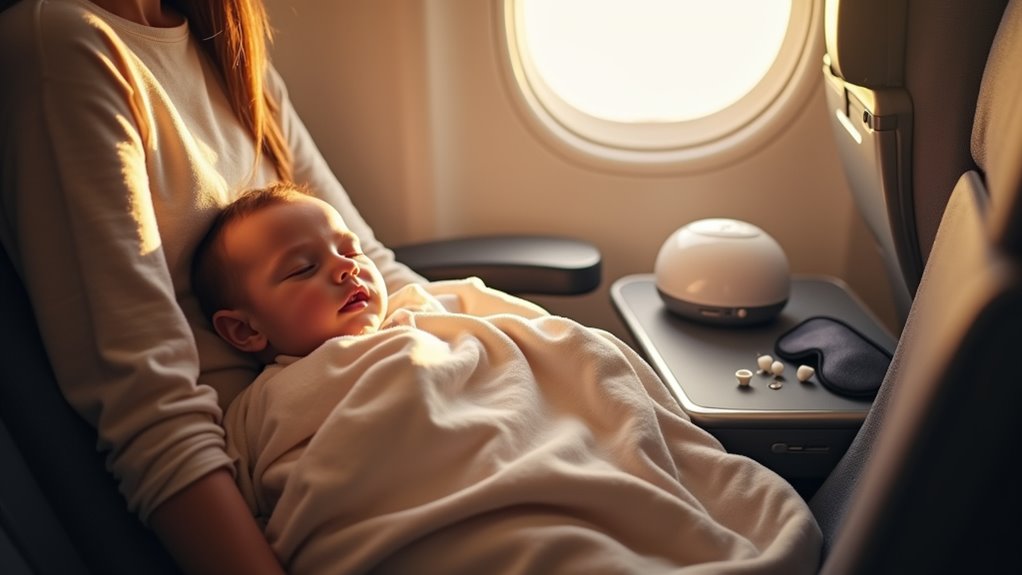
Beyond protecting your infant from germs, you’ll need to tackle one of air travel’s biggest challenges: helping your baby sleep in an unfamiliar, noisy environment.
Creating comfort starts with bringing familiar items that signal sleep time.
Familiar sleep cues from home transform the chaotic airplane cabin into a recognizable, comforting environment for your baby.
Pack these essentials to recreate home’s soothing atmosphere:
Don’t expect perfect sleep—plane naps will likely be shorter and lighter than usual. That’s completely normal.
Focus on mini versions of your bedtime routine, like reading a short book or gentle rocking. Maintain consistent bedtime routine elements even in this new environment to provide familiar comfort cues. Your calm presence becomes their greatest comfort tool.
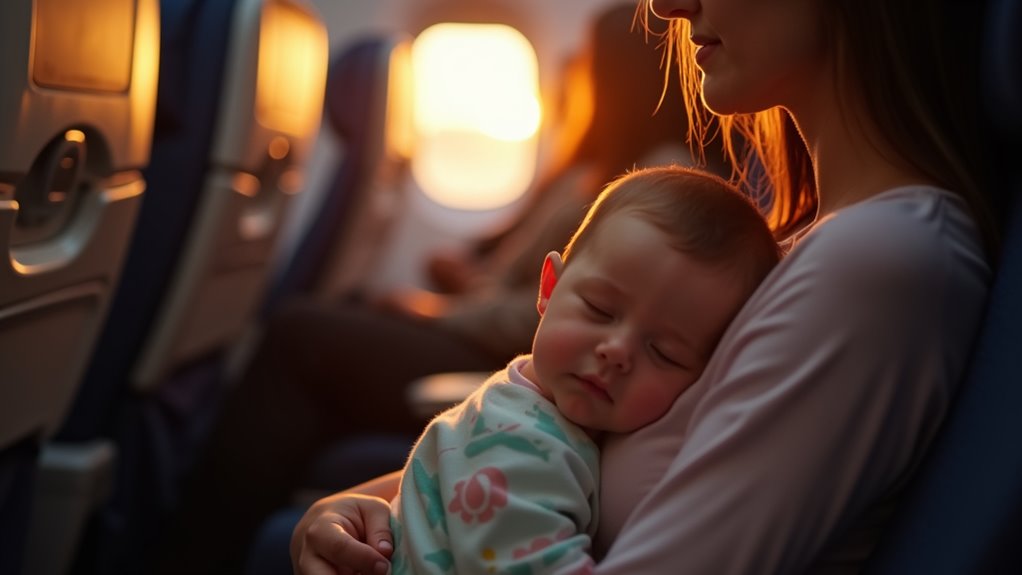
When you’re booking flights with your baby, timing becomes your secret weapon for smoother travel. Consider your infant’s natural sleep patterns when selecting departure times. If your baby sleeps reliably at night, red-eye flights can work in your favor. For daytime sleepers, afternoon departures might be ideal.
Coordinate flight times with feeding schedules to keep your little one content. A well-fed baby is typically a calmer traveler. Avoid booking flights during your baby’s usual fussy periods or peak nap times unless you’re confident they’ll sleep through the journey.
Choose direct flights whenever possible to minimize disruptions. Avoid peak travel hours when airports are crowded and stressful. Remember that each child’s temperament will influence how they respond to different travel times, so consider your baby’s individual personality when making flight decisions.

Flight attendants are your allies in the sky, trained specifically to help families navigate air travel with infants.
Flight attendants are professionally trained allies who understand infant travel challenges and are genuinely prepared to support families throughout their journey.
Don’t hesitate to communicate openly with them—they’re expecting babies to fuss during pressure changes and they’re genuinely supportive of families dealing with crying infants.
Here’s what flight attendants can assist you with:
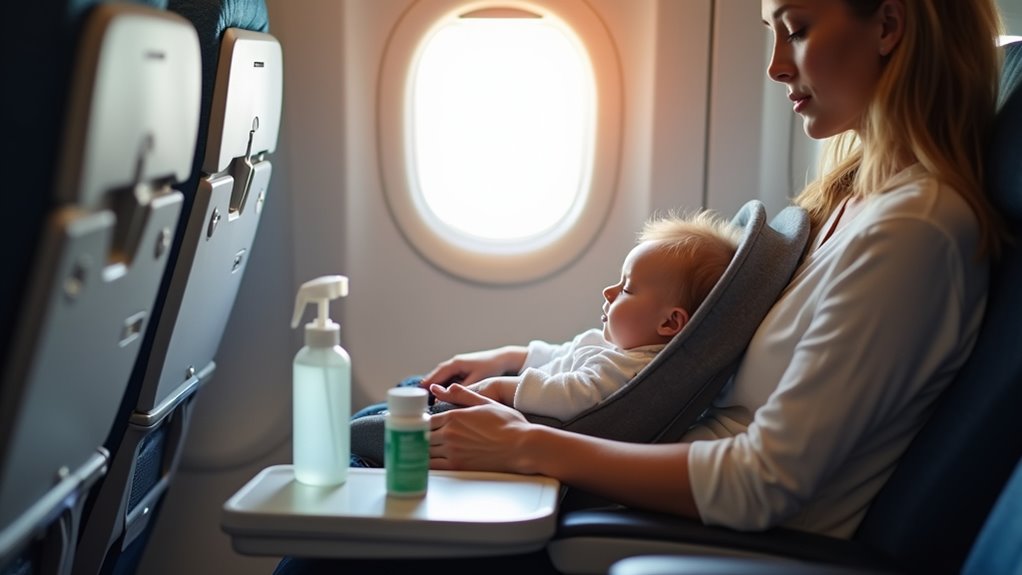
Since airplane cabins expose babies to recirculated air and countless germs from fellow passengers, strengthening your infant’s immune defenses becomes essential for safe travel.
Start by consulting your pediatrician 4–6 weeks before departure about necessary vaccinations like yellow fever, diphtheria, and polio, which vary by destination. However, yellow fever vaccines aren’t recommended for infants under 6 months.
Ensure your baby gets adequate sleep and stays hydrated throughout the journey. For older infants, pack healthy snacks that support immune function. Consider probiotics or elderberry syrup only with medical guidance.
Practice strict hygiene by washing hands frequently and sanitizing surfaces. Use personal wipes on high-touch airplane areas, avoid touching your baby’s face with unwashed hands, and limit exposure to crowded environments when possible. Remember that handwashing is critical to prevent the spread of germs during flights and protects both your infant and other passengers.
Flying with your infant doesn’t have to feel like steering through a storm without a compass. You’ve got the tools and knowledge to make it work smoothly. Trust yourself, lean on the flight crew when you need help, and remember that most passengers understand you’re doing your best. Your preparation will pay off, and before you know it, you’ll be creating beautiful travel memories with your little one. You’ve absolutely got this.